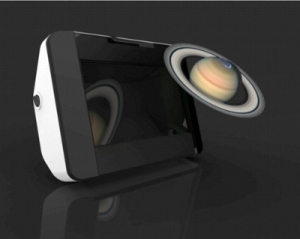Mar 30 2015
Holographic Optical Technologies of Augusta, Georgia, innovator in the field of holographic medical imaging, is entering the world of consumer electronics with the announcement of its Kickstarter campaign. Launching on April 20th, 2015, the campaign will introduce the company's new Voxbox and Voxbox Pro.
The 8-inch and 22-inch displays will allow consumers to view fully three dimensional holograms at home for the first time. In addition to the two displays, the company will also offer a hologram production service. Users can submit nearly any set of 3D data to be made into a Voxgram hologram, such as a set of CT scans obtained from a doctor, a user created 3D model, or a 3D character downloaded from the Internet.
 Holographic Optical Technologies new Voxbox viewer, available for preorder on April 20th exclusively via their Kickstarter campaign.
Holographic Optical Technologies new Voxbox viewer, available for preorder on April 20th exclusively via their Kickstarter campaign.
Voxgram holograms differ from popular holograms in several significant ways. As opposed to the classic Pepper's Ghost parlor trick, or stereoscopic images requiring special glasses, these holograms are not optical illusions – they are 3D sculptures of light that occupy physical space. Voxgram holograms project out towards the observer in front of the portable Voxbox screen, and viewers can reach into them to appreciate their physical depth and intuitively understand their information.
The picture-frame sized Voxbox viewer can be used to display holograms on a desk or mounted on a wall. The larger Voxbox Pro is a medical-grade display, and is used by physicians to view medical holograms. They are also ideal for use in architectural and engineering firms for viewing precise holographic representations of CAD diagrams and other professional grade models.
"Our glasses-free true 3D holograms engage the viewer and offer thrilling experiences for the consumer and better understanding of complex data for improved medical care. Through our Kickstarter campaign we're excited to create a community to join our 3D world," said Daniel Burman, Cofounder of Holographic Optical Technologies, in a recent interview.
This pioneering technology, developed from work by Voxel and Holorad, has already been put through its clinical paces. Earlier versions proved vital in several landmark surgeries, including the 2006 separation of 4-year-old conjoined twins in Utah. Newer versions have met with praise in the fields of neurosurgery and cardiology, two fields of medicine where accuracy is paramount. The company is working with surgeons at a leading medical university to develop new, exciting diagnostic methods and minimally invasive techniques for pediatric neurosurgery. Holographic Optical Technologies has been instrumental in the emergence of medical holography as a sub-discipline of diagnostic medicine.
Through its Kickstarter campaign, Holographic Optical Technologies seeks to raise funds not only to enter the consumer market, but also to help bring its technology into the medical mainstream. One of the campaign rewards allows users to donate medical holograms to children's hospitals in order to get this life saving technology into the hands of those who need it most. There are also options for physicians to purchase Voxbox viewers and Voxgram holograms at a discounted rate in order to bring the technology into their practices.
Stephen Hart, the primary inventor of the technology, and co-founder of Holographic Optical Technologies, has built and operated five generations of holographic printers, the most recent of which is used for the production of all Voxgram images. He originated the system and software architectures of the company's hologram printer and its hologram displays. Prior to his work in holography, Mr. Hart was an experimental astronomer at London's Imperial College of Science and Technology. Mr. Hart was looking for a way to visualize vast amounts of information from astronomical telescopes, and this desire led him to investigate holography as a potential solution. He took an experimental astrophysicist's approach rather than a classical holographer's approach, and, in doing so, pioneered a realm of holography previously believed to be impossible. More recently, this technology was used to create a hologram of the NASA Kepler Mission data, producing the world's largest transmission hologram, measuring six feet high, six feet wide, and projected to a depth of four feet, allowing entire families to walk into a hologram of interstellar space.
The future applications of this technology are limitless. From children's toys to storefront-sized holographic advertisements, true 3D holograms will soon become a part of everyday life. For more information, visit the website http://HolographicOpticalTech.com. For inquires, email [email protected].